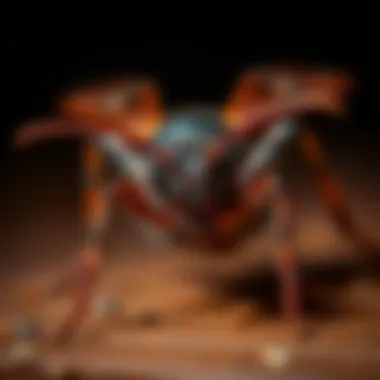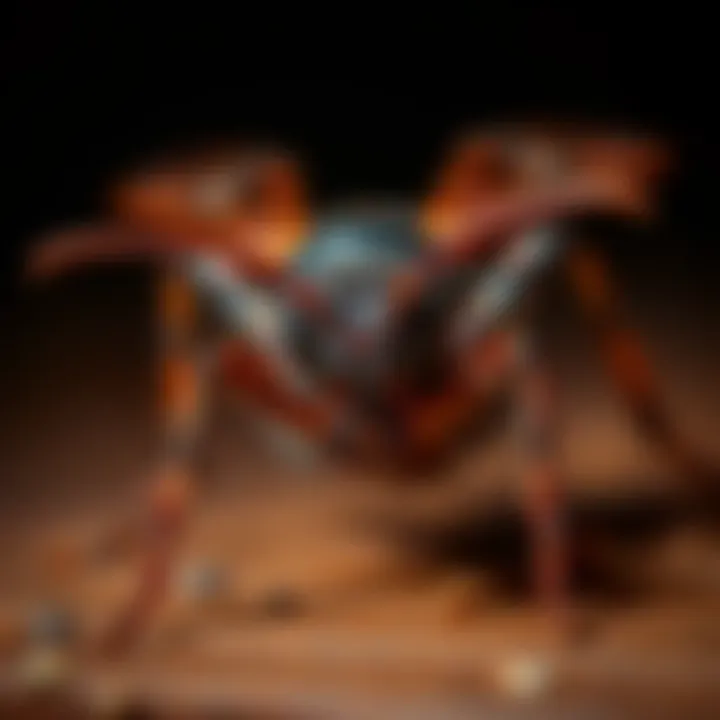Ultimate Guide to Pest Control in Arlington, TX


Intro
Pest control is a key aspect of maintaining a healthy and comfortable living space, especially in Arlington, Texas, where the warm climate provides a perfect breeding ground for a variety of pests. From pesky ants to invasive termites, the local environment can attract an array of unwanted guests. Homeowners often find themselves grappling with these nuisances, leading to the need for effective pest control strategies.
In this comprehensive guide, we will explore the critical elements of pest control specific to Arlington. We will cover how to identify common pests, understand their behaviors, and implement proactive prevention and management techniques. This resource aims to equip both novice homeowners and seasoned pest control professionals with in-depth knowledge tailored to the nuances of pest management in this region.
By delving into the world of pests, we’ll highlight practical methods for preventing infestations and maintaining a pest-free home. Whether you are dealing with a sudden roach sighting or trying to keep your yard free of unwanted critters, the insights provided here will be pertinent to your needs. Let’s get down to brass tacks and uncover the essentials of pest identification.
Prolusion to Pest Control
Pest control is more than just a routine chore. It’s an essential practice that ensures our homes remain safe sanctuaries, free from unwanted critters. When issues arise, they impact not just the aesthetics of our living spaces, but also the health of the inhabitants. Pests can transmit diseases, cause allergies, and even damage property without much thought. With Arlington's warm climate, pests abound, making it crucial to be proactive in our pest management strategies.
Importance of Pest Control
Understanding the importance of pest control can’t be overstated. Here are some key reasons outlining its significance:
- Health Protection: Many pests, such as rodents and insects, can carry harmful bacteria or viruses. Effective pest control helps mitigate these health risks, protecting your family, especially vulnerable members like children or seniors.
- Preventing Damage: Some pests can inflict serious damage on property. For instance, termites can quietly gnaw through wooden structures, leading to massive repair costs. Regular pest control measures can spot such threats before they escalate.
- Increased Comfort: A pest-free home significantly enhances the comfort of your living environment. No one wants to share their space with roaches or ants creeping about.
Pest Control Overview in Arlington
In Arlington, the pest control landscape features a diverse array of pests that homeowners need to be aware of. From ants marching across kitchens to rodents hiding in attics, understanding the local pest population helps tailor specific control strategies.
Local pest control companies utilize methods that consider environmental aspects unique to Arlington, including seasonal behaviors of pests and common entry points in households.
Regular inspections are fundamental. Homeowners should develop an ongoing relationship with pest control experts who can assess their property and advise accordingly, leveraging their knowledge about prevalent pests in the surrounding area.
To keep your home pest-free, consider:
- Engaging with local pest control services for regular maintenance.
- Being aware of seasonal fluctuations that affect pest populations.
- Implementing preventive measures early to avoid infestations.
Common Pests in Arlington, TX
Understanding the common pests in Arlington is crucial for maintaining a pest-free home. Each household can be susceptible to different kinds of pests, and knowing their habits and characteristics can help residents take preemptive action. Identifying these pests, recognizing their preferences, and understanding the environmental conditions to which they are most often attracted can make a significant difference in keeping your living space comfortable.
Identifying these pests early on can often prevent a minor nuisance from spiraling into a full-on infestation. Homeowners who keep an eye out for signs of these critters can take timely action, whether through DIY methods or by engaging professional pest control services. With Texas's warm climate, specific pests are more prevalent in Arlington. This is where the importance of knowing these pests comes into play.
Identification of Common Household Pests
In Arlington, the roster of common household pests is as diverse as it is troublesome. Here’s a look at some pests that you'll likely find in or around your home:
- Ants: These little buggers come in various types, such as fire ants and carpenter ants. Their colonies can become large and overwhelming. It’s not uncommon to spot a line of them marching toward food.
- Cockroaches: The American cockroach is a common culprit in many homes. They are nocturnal and prefer dark places. Their presence not just indicates filth, but can also be a health issue.
- Termites: Known as silent destroyers, these pests can cause significant structural damage before homeowners even realize they’re present. Common signs include mud tubes and wings discarded near light sources.
- Rodents: Mice and rats are a significant cause for concern. They gnaw on anything from wires to food packets, and can introduce diseases.
- Bed Bugs: These pests have made quite the name for themselves in recent years. They thrive on human blood and are known for their itchy bites. Spotting them can be tricky, as they are skilled at hiding.
By knowing what to look for, including physical appearance and behavior, homeowners will be better prepared to identify issues sooner rather than later.
Seasonality and Pest Populations
Pest populations aren’t static; they ebb and flow with changing seasons. In Arlington, the warm climate plays a unique role in pest activity. Understanding how pest populations can shift with the seasons allows residents to plan accordingly.
- Spring and Summer: As temperatures rise, many pests awaken from their dormancy. Ants begin to forage for food, and termite colonies venture out for mating season. Wasps and hornets, too, become busy during these warmer months. This is typically when infestations ramp up.
- Fall: With the cooler weather comes a rush for many pests looking for shelter. Rodents start seeking warmth, which could lead them into homes and garages. Flying insects, like houseflies, will also start seeking refuge inside.
- Winter: Many pests can be inactive during the winter months, but some, like cockroaches or rodents, don’t follow this pattern and can still cause problems.
By knowing how different pests behave seasonally, homeowners can prepare their homes, whether that means reinforcing entry points or simply being on the lookout for early signs of infestations. It’s also wise for residents to engage in preventative maintenance all year long to mitigate potential pest issues.
"A few preventative steps in pest management can go a long way in ensuring a clean and healthy living space."
Pest Identification Techniques
When it comes to effective pest control, identification is crucial. Knowing what you're dealing with can mean the difference between a temporary annoyance and a persistent infestation. In Arlington, the climate and environment can foster a variety of pests, each with its unique characteristics and behaviors. Proper identification not only helps in selecting the most appropriate control methods but also assists in predicting potential problems.
Visual Inspection Methods
Visual inspection is the first step a homeowner can take in identifying pests. It involves a thorough look around your home and yard. Here are some key points to consider:


- Look for Signs: Droppings, nests, and markings can all indicate the presence of pests. For instance, small black pellets in your pantry may suggest a rodent problem, while tiny, white insect bodies can indicate a bed bug issue.
- Check Common Hiding Spots: Many pests like to hide in dark, warm places. Check behind appliances, inside cabinets, and around door frames. Termites often leave signs behind them like mud tubes; being aware of such signs helps you catch issues early.
- Seasonal Changes: Pests behave differently with the changing seasons. For example, ants tend to be more active in spring and summer. Looking for seasonal patterns may alert you to potential problems even before they become noticeable.
- Document Findings: When doing your inspections, it can be helpful to take notes or photographs. This way, you can track any changes over time, which may assist pest control professionals if you need to call in for help.
Behavioral Observation
Behavioral observation goes beyond simply seeing pests; it’s about understanding how they act. Paying attention to behaviors can provide clues to their identification:
- Activity Patterns: Different pests have distinct activity times. For example, cockroaches are nocturnal and tend to scurry around in the dark. Recognizing when you’re seeing pest activity can point to specific species.
- Feeding Habits: Noticing what pests are feeding on can further aid in identification. If you find food resources being damaged, such as wooden structures or paper products, you may be looking at termites or even silverfish.
- Response to Stimuli: Some pests react visibly to changes in their environment. For instance, if you turn on a light in a dark room and see tiny insects skittering away, you may have a fruit fly issue.
The methods of pest identification, combining visual inspections with behavioral observations, form a solid groundwork for effective pest management.
Using two-pronged strategies not only helps in recognizing familiar pests but also alerts you to newcomers that might cause trouble in the future. Given that Arlington experiences varied weather conditions and has its fair share of pest challenges, being observant can save you time, money, and headaches down the line.
Ultimately, thorough identification can empower homeowners to take the necessary steps in prevention and, when needed, act quickly to eliminate infestations.
Prevention Strategies for Homeowners
Effective pest control begins long before a pest ever sets foot in your home. Prevention is the name of the game. For homeowners in Arlington, Texas, it’s vital to adopt specific strategies that not only keep unwanted critters at bay but also promote a healthier living environment for you and your family.
By implementing these preventive measures, you can reduce the likelihood of infestations and save yourself from the hassle and cost associated with dealing with a pest problem. Moreover, you contribute to a safer ecosystem—both for yourself and local wildlife.
Role of Cleanliness and Hygiene
A tidy home is less appealing to pests. Maintaining cleanliness is the cornerstone of pest prevention. It is crucial to keep your home as neat as a pin, focusing on both visible areas and the nooks and crannies often ignored.
- Kitchen Duties: Ensure all food items are stored in sealed containers. Crumbs and spills can attract ants, roaches, and other pests quicker than you can say "pest control". Clean dishes right after meals and wipe down countertops.
- Regular Garbage Disposal: Don't let trash pile up. Dispose of garbage regularly and use bins with tight-fitting lids. Ladybugs may be charming, but a swarm of flies during the summer—definitely not!
- Vacuum Often: Just like we humans need to stay active, regular vacuuming helps remove food particles and insect eggs from your floors and carpets.
Cleaning is not about being obsessive; it's about being responsible. A clean home shows that you care for your space and the environment—and it is also less hospitable to pests.
Sealing Entry Points
A well-sealed home is your fortress against pests. Just as important as keeping your home tidy is ensuring that you close off possible intruder pathways. Pests are crafty little buggers, and they'll find their way in if given half a chance.
- Inspect Windows and Doors: Check for gaps around window frames, doorways, and especially around garage doors. Weather stripping and caulking can work wonders here. A little investment in sealing can save you big bucks in pest control bills down the line.
- Foundation and Basements: Look for cracks in the foundation and seal them up. These tiny openings can give spiders and mice a welcome mat into your home.
- Utility Lines: Pay attention to any utility lines entering your home. Create barriers with caulk or foam to keep pests from sneaking through.
By sealing entry points effectively, you create a formidable barrier that discourages pests from making themselves at home in your sanctuary.
Landscaping Considerations
Your yard is the first line of defense against pests, and the right landscaping choices can significantly reduce infestations. Mindfully designed gardens not only beautify your property but can work as a deterrent against various pests.
- Plant Choices: Consider opting for plants that repel insects. For instance, lavender or marigolds are known to keep certain bugs at bay, while others can attract beneficial insects that prey on pests.
- Trim and Maintain: Trim bushes and shrubs to reduce hiding spots for pests. Make sure that no branches or plants touch your home, creating a bridge for pests to climb aboard.
- Standing Water: Avoid areas that hold standing water, as they become breeding grounds for mosquitoes and other pests. Ensure proper drainage in your garden to manage water effectively.
In summary, sensible landscaping is not just aesthetic; it's a proactive measure to keep pests out.
"An ounce of prevention is worth a pound of cure." By focusing on cleanliness, sealing entry points, and landscaping, homeowners in Arlington can significantly minimize pest problems and maintain a peaceful home environment.
Do-It-Yourself Pest Control Methods
In the realm of pest control, Do-It-Yourself (DIY) methods stand as both a practical and economical choice for many homeowners in Arlington, TX. These methods empower individuals to take charge of their living spaces, often yielding effective results without the hefty price tag associated with professional services. The essence of DIY pest control lies in its accessibility; it offers immediate solutions to pesky problems and can alleviate the worry of widespread infestations.
When dealing with common pests, understanding that quick action often yields faster results is key. DIY methods are not only about eradicating the current problem but also about preventing future occurrences. This dual approach can save both time and money in the long run. It's essential, however, to keep in mind that while DIY methods are effective for minor infestations, a major problem may still necessitate professional intervention.
Natural and Homemade Solutions
Natural and homemade solutions serve as the backbone of DIY pest control for many in Arlington. These options often utilize readily available household items, making them economical and eco-friendly. Here are a few popular methods:
- Vinegar Spray: A mix of equal parts vinegar and water can repel ants, roaches, and other unwanted critters. Spraying this on surfaces disrupts their scent trails, deterring them from returning.
- Essential Oils: Essential oils like peppermint, lemon, and tea tree oil possess natural insect-repelling properties. Mixing a few drops with water in a spray bottle can create a pleasant-smelling barrier against pests.
- Diatomaceous Earth: This naturally occurring substance is effective for pests like fleas and bed bugs. Sprinkling a light dusting around areas prone to infestations can help control their numbers. Just remember to keep it away from pets and small children.
Each of these methods showcases the potential of easily accessible items, highlighting how effective solutions can be just a household ingredient away. Be cautious with any homemade remedy; safety should always be a priority, especially when attempting to eradicate pests around kids and pets.
"Using natural solutions not only protects your home but also helps ensure the integrity of your local ecosystem."
Commercial Products Overview


For homeowners who prefer a more targeted approach, commercial pest control products offer a range of solutions tailored for specific infestations. These products, available in local stores or online, often feature ready-to-use formulations that adhere to safety standards without compromising effectiveness. Here are some categories of commercial products to consider:
- Sprays and Insecticides: For immediate action against visible pests, these sprays can provide quick mitigation. Always look for products labeled for indoor use to minimize risk.
- Traps: Glue traps and bait stations are excellent choices for capturing rodents and insects without using harmful poisons. They are designed to reduce populations discreetly and effectively.
- Repellents: These products create an invisible barrier, keeping pests at bay. Look for long-lasting options designed to work even in external areas.
When using any commercial product, it’s important to follow the instructions provided carefully. Misuse can not only lead to ineffective results but also pose safety risks to your family and pets.
When to Seek Professional Help
In the realm of pest control, knowing when to call in the pros can be a game changer. While DIY methods can handle minor nuisances, certain situations demand the expertise of trained specialists. Understanding the signs and evaluating the severity of the infestation is crucial to protecting your home and well-being.
Signs of Severe Infestations
When pests invade your space, it's common to feel like an intruder is camped out in your living quarters. However, not all pest problems are created equal. Here are several indicators that should prompt immediate consideration of professional intervention:
- Unexplained Damage: If you notice gnaw marks on furniture, walls, or insulation, that’s often a clear sign of rodents. Termites, on the other hand, may leave behind hollowed wood or mud tunnels.
- Excessive Droppings: Finding droppings in multiple areas of your home signals a larger problem. For example, mouse droppings are small and dark, while cockroach droppings resemble black pepper. The more you find, the more urgent it is to act.
- Foul Odors: Certain pests like dead rats or decomposing insects can emit a strong, unpleasant smell. If you catch a whiff of something sour or rotten, it could indicate that it's past time to take action.
- Visible Nesting: If you’re spotting actual nests or colonies—be it wasp, bee, or termite colonies—it’s likely that they’ve significantly established themselves, making removal much trickier.
- Health Issues: Pest infestations often come with health risks; allergens from dust mites or droppings can trigger asthma or other respiratory issues. If you notice increased allergy symptoms among household members, checking for pests should be high on your to-do list.
Taking note of these signs early can save you from bigger headaches down the road.
For residents in Arlington, recognizing these signals can mean the difference between a manageable situation and a costly infestation.
Choosing a Pest Control Service
Once it's clear that professional help is needed, the next step is selecting the right pest control service. With so many options available, how do you ensure you make an informed choice?
Start by researching local companies. Look for reviews on platforms like Yelp or Google, as real feedback can shed light on their effectiveness. It’s sensible to ask for recommendations from friends or family who’ve had similar issues.
When you begin contacting potential service providers, consider the following factors:
- Certifications and Experience: Ensure the company has the required licenses from the Texas Department of Agriculture. An experienced company is typically better equipped to handle a variety of pests.
- Methods Used: Inquire about the pest control techniques they employ. Are they using chemical treatments, traps, or more eco-friendly options? Understanding their approach will help you determine if their methods align with your values.
- Warranty and Follow-Up Services: Some businesses offer warranties for their services, which can provide peace of mind. Additionally, see if they offer follow-up visits to ensure the problem has been fully resolved.
- Estimations and Pricing: Obtain estimates from several companies to compare prices. Be wary of quotes that seem too good to be true; they often indicate subpar service.
- Emergency Services: Certain situations may require immediate action. Make sure to clarify if they offer emergency services in case of a severe outbreak.
Taking the time to choose the right pest control service can make a significant difference in the overall effectiveness of pest management in your home. When faced with those little critters that disrupt your peace, don’t hesitate to act decisively. A pest-free home is worth the effort.
Regulations and Safety in Pest Control
When it comes to pest control in Arlington, TX, understanding the regulations and implementing safety measures is crucial for homeowners and pest control professionals alike. First and foremost, regulations serve to protect not only the environment but also the health of residents and their pets. Dealing with pests isn't as simple as grabbing a can of insecticide; it requires compliance with local guidelines to ensure that methods used are both effective and responsible.
The benefits of adhering to these regulations are numerous. For one, they help to minimize the use of harmful chemicals that can seep into the soil and water supply. When pest control practices align with state and local laws, they are more likely to keep the balance in the ecosystem intact. Moreover, understanding these guidelines can offer peace of mind, knowing that you're following legal protocols while safeguarding your household.
From licensing requirements for pest control operatives to restrictions on specific pesticides, knowledge is power in this arena. Always be informed and stay updated, as laws can change faster than pests can multiply.
State Regulations for Pest Control in Texas
Navigating the landscape of pest control regulations in Texas can feel like a maze, but it’s crucial for anyone engaged with pest management. The Texas Department of Agriculture (TDA) oversees these regulations, ensuring that pest control services follow set guidelines to protect people and the environment.
Key points to note about Texas pest control regulations include:
- Licensing: Pest control operators must hold a valid license issued by the TDA. This ensures that they are trained and knowledgeable about safe practices in managing pest populations.
- Use of Chemicals: Not just anyone can use potentially harmful pesticides. The TDA specifies which chemicals are allowed and under what circumstances. Misuse can lead to fines and even endanger local wildlife.
- Record Keeping: Licensed pest control companies are required to keep detailed records of their treatments. This is important for both accountability and tracking the efficacy of various methods used in residential homes.
Being aware of these details is important whether you are hiring a pest control service or tackling pests on your own.
Safety Measures for DIY Pest Control
Tackling pest issues on your own can be tempting, particularly if you want to avoid the expense of hiring a professional. However, safety should never be an afterthought. When going the do-it-yourself route, here are some safety measures to keep in mind:
- Read Labels Thoroughly: Always start by carefully reading the labels of any products you plan to use. These labels often contain vital safety instructions and information about what to wear while applying the pesticide.
- Protective Gear is a Must: Gloves, goggles, and masks are your first line of defense against chemicals. Even if a product states it's safe, precaution never hurts.
- Ventilation: Make sure the area you are treating is well-ventilated. Opening windows or using fans can help mitigate exposure to harmful fumes.
- Store Products Safely: Always keep pest control products out of reach of children and pets. A locked cabinet is the safest choice.
- Be Mindful of Environmental Impact: Select products that have fewer environmental consequences. And even when you do choose to use pesticides, make sure you apply them sparingly as overuse can lead to pest resistance or harm beneficial insects.
Remember: The goal of effective pest control is to eliminate unwanted pests, not to create new issues.
By combining regulatory knowledge with sound safety practices, homeowners in Arlington can tackle pest problems more effectively, ensuring their methods are not only practical but also mindful of legal and ecological boundaries.
Environmental Considerations


Understanding the environmental considerations surrounding pest control is paramount for homeowners in Arlington, TX. With the increasing awareness of ecological balance, it becomes essential to address the impact of pest control practices on local ecosystems. The essence of effective pest management does not lie solely in eradication but in maintaining harmony between human habitats and nature. This brings forth a need for a comprehensive approach that prioritizes sustainability while addressing pest issues.
Impact of Pesticides on Local Ecosystems
The use of pesticides can have far-reaching consequences on the environment. These chemicals, while effective against pests, can inadvertently affect non-target species and disrupt the food chain. For instance, when pesticides seep into the soil or run off into nearby water bodies, they can harm beneficial insects such as bees and butterflies, which play crucial roles in pollination.
Moreover, aquatic ecosystems can suffer significantly due to contamination. Fish and other marine life may experience toxic effects, leading to a decline in biodiversity. It's crucial for Arlington residents to understand that the immediate elimination of pests shouldn't come at the cost of long-term environmental health.
- Some key impacts include:
- Decline in pollinator populations
- Disruption of natural predator-prey relationships
- Water quality degradation
- Accumulation of toxins in the food web
Given these risks, homeowners are encouraged to educate themselves about the potential consequences of their pest control methods. Avoiding excessive or inappropriate use of pesticides can contribute positively to protecting the local environment.
Sustainable Pest Management Practices
Sustainable pest management practices focus on long-term solutions that minimize harm to both the environment and human health. These methods prioritize prevention and employ eco-friendly strategies that align with the natural behavior of pests. Here are some examples of sustainable practices homeowners can adopt:
- Integrated Pest Management (IPM): This approach combines biological control, habitat manipulation, and monitoring techniques to manage pests effectively without relying solely on chemicals.
- Use of Biopesticides: Biopesticides derived from natural materials can be potent alternatives to synthetic pesticides, reducing ecological impact while effectively managing pest populations.
- Encouraging Natural Predators: By creating an ecosystem that supports the presence of natural enemies of pests, such as ladybugs and birds, homeowners can enhance pest control naturally.
- Regular Monitoring: Keeping an eye on pest populations can help homeowners understand pest behavior and intervene before infestations occur.
Implementing these sustainable practices can lead to reduced reliance on harmful pesticides, fostering a healthier environment for both people and wildlife. It's a simple yet profound way that Arlington homeowners can contribute to ecological preservation while managing pests effectively.
"Sustainable pest control is not just about managing pests; it's about nurturing our environment and ensuring a balanced ecosystem for future generations."
By being proactive and educated about pest control methods, homeowners can take significant strides toward a pest-free living space, minimizing the damage to the incredibly rich ecosystems present in Arlington, TX.
Recent Trends in Pest Control
In the realm of pest control, staying updated with the latest trends is crucial for effective management strategies. With rapid changes in urban living and environmental awareness, the pest control landscape continues to evolve. Recent trends focus not just on eradicating pests but also on sustainable and preventative approaches that align with a more eco-conscious ethos. Homeowners and pest control experts alike benefit from understanding these trends, as they can significantly impact the effectiveness and efficiency of pest management practices in Arlington and beyond.
Emerging Technologies in Pest Control
Technology plays a pivotal role in transforming pest control methods today. Advanced tools and techniques enhance effectiveness while minimizing chemical use. For instance, smart traps equipped with sensors can notify homeowners or pest control services when pests are detected. These modern solutions make it easier to monitor pest activity and respond promptly, reducing infestation chances before they spiral.
Moreover, drones are increasingly used for pest surveys, especially in hard-to-reach areas. They provide a bird's-eye view of your property, helping to identify potential problem zones. By employing this type of technology, services can deliver targeted treatments rather than blanket applications, resulting in better outcomes.
- Automated pest detection systems are now capable of identifying pests through image recognition.
- Heat treatment is gaining traction for its effectiveness against bed bugs, often reducing the need for harmful chemicals.
- Remote monitoring technologies can track pest populations and even predict outbreaks, giving homeowners the advantage of early intervention.
As these technologies advance, they not only improve pest eradication rates but also support more responsible, environmentally-safe methods.
Research on Pest Behavior and Control Methods
Understanding pest habits informs more effective pest control strategies. Recent research in pest behavior reveals fascinating insights that can shape treatment methods. For instance, studies show that specific pests respond favorably to certain natural repellents, suggesting an effective and less toxic way to keep them at bay.
Research is also shifting toward understanding pests' resistance to various control methods. With pests like cockroaches and ants developing resistance to traditional baits and sprays, researchers are conducting thorough analyses to find combinations or alternative methods that can outsmart these resilient creatures.
Furthermore, behavioral studies have discovered that environmental factors—such as lighting, humidity, and temperature—significantly influence pest activity. This knowledge allows homeowners to adapt their environment, potentially deterring unwanted guests before they even enter.
- Cognitive Mapping: Researchers are looking into how pests navigate and remember environments, potentially leading to better bait placement.
- Chemical Communication: The study of how pests communicate with pheromones could unlock new strategies for traps, mimicking these signals to attract or repel pests.
Ending
The journey through pest control in Arlington serves to underscore the vital role effective management strategies play in safeguarding our homes. In a region where pests like mosquitoes, ants, and termites can easily take hold, understanding the landscape of pest control is not just beneficial; it’s essential for creating a safe living environment.
Summary of Pest Management Strategies
Effective pest management rests upon a solid understanding of various strategies that can be utilized. From maintaining cleanliness and sealing potential entry points, to employing natural and commercial products, the options are many. Key points include:
- Regular Inspections: Keeping a watchful eye on your surroundings helps catch infestations before they spiral out of control.
- Sanitation: Garbage management and food storage are crucial in reducing attractants for pests.
- Landscape Maintenance: Designing your garden and yard in a way that discourages pest habitation is often overlooked.
- Use of Eco-friendly Solutions: Choosing organic methods not only protects your family but also the environment.
In Arlington, home-owners should tailor these strategies to fit individual circumstances for the best results.
The Future of Pest Control in Arlington
Looking ahead, the future of pest control in Arlington appears bright, yet it’s anything but certain. As technology advances, pest control measures are increasingly incorporating automated solutions and smart technology.
- Emerging Technologies: Innovations like drone surveillance for pest identification and AI-driven monitoring systems promise to change the way pest management is approached.
- Sustainability Focus: More professionals and homeowners are recognizing the necessity of eco-friendly pest control solutions, mirroring a broader trend towards sustainable living.
- Education and Awareness: Ongoing research and dialogue in local communities will play a crucial role in spreading awareness about effective pest management strategies.
Embracing these forward-thinking solutions can ensure that Arlington remains a comfortable, pest-free place to live, reinforcing the bond that locals have with their homes. This narrative emphasizes the dynamic nature of pest control, making it a subject worth following as it evolves.















